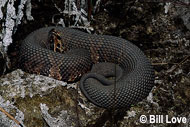Description:
Some of the many vernacular names for this snake are water moccasin, swamp adder and trapjaw. This is a rather slow moving, abundant, viperine snake that is quite apt to stand its ground rather than run if frightened. It is a semi-aquatic species that swims readily and well—and just for the record, it is very capable of biting while submerged. Adults are big dark snakes that have wide, albeit often obscure, bands, light cheeks and a prominent eyestripe. As well as having the trademark eyestripe babies are prominently banded. If threatened the cottonmouth is quite apt to coil, tip its head backward, and gape widely, displaying the cottony-white mouth lining. This is a dangerously venomous snake. Because of its carrion eating habits, a cottonmouth bite often results in a secondary infection that may be more difficult to treat than the actual envenomation. A 50 to 75 gallon capacity terrarium will suffice for one or a pair of eastern cottonmouths. The substrate should be dry and may consist of folded newspaper, several thicknesses of paper towels, aspen shavings or cypress shavings. A hide box and visual barriers should be present in the cage. A water receptacle sufficiently large for the snakes to both drink and soak must be provided. The water must be kept fresh and clean. Daytime illumination should be provided. Room temperature 76 to 83 degrees Fahrenheit is a suitable temperature for the terrarium. Nighttime temperatures of about 70 degrees are adequate. A daytime hot spot of about 92 to 95 degrees should be provided by a basking lamp. If kept merely as a pet, the cottonmouth may be kept warm and active all winter long and it will usually continue to eat. However, they may choose to miss a meal during the cooler winter months. If you intend to breed these snakes, they will probably require a 90 day period of dormancy. The eastern cottonmouth preys upon fish, amphibians, other snakes, baby turtles, baby alligators and small rodents. Most captives, whether neonate or adult, readily accept mice. Fewer than 12 large neonates (cottonmouths are viviparous) are produced in each litter. The babies are more brightly colored and patterned than the adults. Neonates are about 9 inches to a foot long. These snakes may be moved with either a snakehook or a clampstick.
Habitat:
The cottonmouth is most abundant in the proximity of watercourses, be they ponds, swamps, marshes, canals, slow-rivers, lake edges or oxbows. However, it is occasionally found some distance from water, especially as seasonal ponds dry and it seeks new habitats and food sources.
Range:
This coastal plain and Piedmont snake ranges southward from southeastern Virginia to central eastern Georgia.
Scientific Name: Agkistrodon piscivorus piscivorus
Species Group: venomous
Family: Viperidae
Size: Most eastern cottonmouths are adult at 3 to 4 feet; occasional individuals attain 6 feet in length.
Level: advanced
Weight:
Dangerous: No


